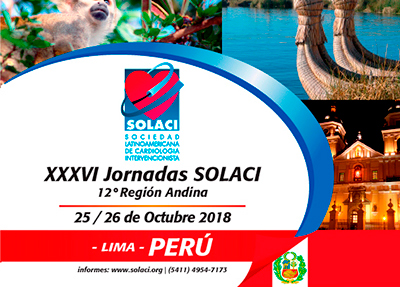“Fostering Hemodynamics among Young Cardiologists”.
 It is with great pleasure that we hereby invite all young Latin American cardiologists specializing in hemodynamics to submit relevant clinical cases to the next SOLACI Sessions, Lima, Perú, to be held on October 25th and 2nd, 2018.
It is with great pleasure that we hereby invite all young Latin American cardiologists specializing in hemodynamics to submit relevant clinical cases to the next SOLACI Sessions, Lima, Perú, to be held on October 25th and 2nd, 2018.
HOW TO PRESENT A CASE
-
- Case submission is meant for young Latin American interventional cardiologists and topics include: adult peripheral vascular and structural heart interventional cardiology.
- In each case, only one interventionist can sign up. Being a fellow cardiologist or interventionist is not required.
- Attach a letter of recommendation from the Chief of the Hemodynamic Service you belong to.
- Send a Word file with your case description, no longer than 300 words, font size 11.
- Send a complementary Power Point file with your case presentation. Even though you may use videos (up to 5) for your oral presentation during our sessions (up to 5), this initial file may only include up to 5 pictures only.
- One cardiologist may present more than one case. If such were the case, they should be sent separately.
- Include personal information: name and last name, phone number, email address, case title and institution you are working for.
WHERE TO SUBMIT A CASE
Cases must be submitted through the following form
If you have problems with the form, send your case directly to webservices@solaci.org and jornadas@solaci.org, complying with the requirements requested here (summary of the case in word, file of the case in PPT, endorsement letter, personal data, etc.”
DEADLINE
Tuesday, September 25th, 2018.
EVALUATION PROCESS
All cases will be initially evaluated by the appointed committee and shortlisted to the best 8, which shall be presented orally during our sessions. During these presentations, a second complementary evaluation will decide on the winner.
PRIZE
The winner shall obtain a full scholarship to attend one of the upcoming SOLACI Sessions, including plane tickets, lodging, and registration fees for such event.





